
|
Note ye ed's email address: stevebryant99@gmail.com. |


Vintage mentalism from the Miracle Factory.
|
Return to our August 2019 issue to join Noel Britten's Bizarre Bath walk, to attend a close-up show at London's Magic Circle, and to enjoy Harry Potter and the Cursed Child. |
September 2019 First and foremost: Congratulations to Noel Britten for becoming the new president of the Magic Circle. It's hard to imagine a nicer guy or a more accomplished professional magician for the post. I am still abuzz from the thrill of joining his walking tour of Bath, reported last month. Elsewise it's been a busy September, resulting in reports below on Annemann's Enigma from The Miracle Factory, a Ricky Jay tribute issue of Gibeciere, Nick Trost's Subtle Card Creations Volume 7 (published at last), and two sensational live magic shows at the Bloomington Playwrights Project. I had hoped to add notes on Interpreting Magic, but the Regal has not yet landed in Indiana. Maybe next month. And isn't there a Genii convention coming right up? |
|
|
THE SHORT TROUBLED LIFE OF THEO J. ANNEMANN -- Fresh off the press from Todd Karr, in the usual classy Miracle Factory format, is Annemann's Enigma, the biography-anthology of Ted Annemann, who in a brief and sometimes difficult life of only 35 years positioned himself as the most influential mentalist of the twentieth century. The book is a massive hardback collection of Annemann's biography along with virtually all his writings except The Jinx. The Jinx itself is provided on CD as a fully searchable pdf. I grew up on Practical Mental Effects, with material culled and categorized from The Jinx. I later expanded my Annemann reading to The Jinx proper, and the appearance of the Jinx Companion, from Gordon Meyer, Craig Conley, and Fredrick Turner, made owning The Jinx even more fun. Unlike most classic texts from the early part of the last century, The Jinx contained material that I actually performed over the decades. To apply a quote from Geoff Latta, the tricks were fun to do and fun to watch. On the other hand, I had not dipped into Annemann's earlier writings, hence most of the material in Todd's new book was new to me, and thus a treat. Contents follow ... A pair of brilliant forewords from Max Maven and Steranko establish Annemann's context. Max notes the Industrial Revolutions's gift to Western life: leisure time, leading to the rise of the amateur magician, along with changes in performing opportunities. There was a new market for clubs and periodicals. Steranko intrigued me with the claim that Annemann regarded Dunninger as the rival from whom he wanted to steal the spotlight, stealthily, by publishing "his avant-garde manifesto," and overtly on stage with no less than the Bullet Catch. The magazine's popularity rose even higher with contributions from Harold Lloyd, Barbara Stanwyck, Chester Morris, and Jimmy Stewart. Steranko also had some amusing insights as to magicians Annemann was not like. Both essays are must reading.  Photos abound. Todd Karr follows with a 73-page Annemann biography, rich with photos, history, and insight. Perhaps the story is best summed up in a line from Bruce Elliott: "[Annemann] concentrated on his legend with ferocious energy ..." The saddest Annemann info to me, beyond his drunken attempt at performing Test of the Tiber, beyond even his suicide, is that he had a beautiful daughter, Mona, whom he never seemed to know. Among the (many) things I did not know about Annemann is that he desired to be editor of Greater Magic after Hilliard died. Carl Jones passed him over for Jean Hugard, but Annemann was no doubt pleased to be named one of Greater Magic's "Card Stars." And then there is all of Annemann's writing ... I. Annemann's Articles includes his contributions to other journals, mostly The Sphinx and The Linking Ring. From the start, he wrote with the confidence that he had a loyal and growing constituency. The tricks are grouped year by year, from 1924 (he would be age 17) through 1933. Among many, I particularly enjoyed his Torn Card Method (1931). II. Annemann's Essays are two articles written for the general public, one on False Mediums and Their Marvels (Ghost Stories magazine) and one on on the Bullet Catch (True magazine). III. Exclusive Manuscripts were mimeographed manuscripts (collections of tricks) sold individually. These marked Annemann's first forays into publishing.  All the books are there. IV. The Books With a Name contains the complete texts of Annemann's books : Card Miracles, Mental Mysteries, The Book Without a Name, 101 Methods of Forcing, Strange Secrets, 202 Methods of Forcing, Climax Card Routine, S-h-h-h-! It's a Secret, Annemann's Complete One-Man Mental and Psychic Routine, Annemann's Mental Bargain Effects, En Rapport, The Jinx Programs, and other books (introductions, etc. that Annemann wrote for other books). I made a long list of standout routines, but will only note here that most came from S-h-h-h-! It's a Secret. The One-Man Mental routine contains some sensational billet switching that would have fooled me badly, and I also enjoyed the complete two-person routine from En Rapport. Yes, there is a code, but it is simple and used to convey only info you couldn't know, speaking directly to the spectators, not the medium. It would entertain today. V. Advertised Effects are 23 more tricks, mostly mimeographed instructions. Test of the Tiber is among them. VI. Annemann Afterward are posthumous items from Annemann, mostly written up for various journals by Max Holden, Walter Gibson, or Bruce Elliott. The Window Washers' Dream is a particularly amusing illusion, based on a Harold Lloyd eyeglass gag. There are five appendices. Appendix 1 Annemann Quotes are quotes drawn from the books discussed above and from the pages of The Jinx. From the start, Annemann had a gravitas, with plenty of interesting thought about mentalism and its presentation. He was always quotable, and I expect this section of the book will be the one I turn to most often in the future, for the simple pleasure of hearing the Annemann voice. A couple of examples: "Clever people are to be found in the audience as well as behind the footlights, a point which many magicians overlook," and, "Don't believe a damned thing you read in any magical journal until you've tried it." Appendix 2 Postmark: Waverly is a selection of correspondence, mostly from a young Annemann to Al Baker, beginning in 1923, when Annemann was 16. Provided by Max Maven. Appendix 3 The Most Dangerous Trick in Magic is a 1950 article for True magazine by William Lindsey Gresham. It discusses the Bullet Catch of course, surrounded by biographical detail.  What a thrill to receive this in the mail! Appendix 4 The Jinx bibliography is just that, a complete list of every issue, every extra. Well, sort of, because then there also is ... Appendix 5 The Fake Jinx. Ah, boys will be boys. Long before there was a Wenii or a Majoke, there was a fake issue of The Jinx, a spoof concocted and executed by Annemann friends Robert W. Weill and Ralph Hinkson. Although he originally approved the idea, Annemann changed his mind and and stopped, as best he could, its dissemination. (Perhaps because it contained a "method" for the Bullet Catch?) According to Jay Marshall, only a dozen survived. It is here in this appendix.  Bonus issue of The Jinx. There was eventually a Jinx issue of Genii, in October 2009 (a fantastic tribute), and Todd Karr provides a Jinx Enigma Extra, included in the CD envelope. The extra contains, among other things, important letters from Annemann to Orville Meyer, discovered after the new book had gone to press. What a clever way to add detail! Getting back to the book, it closes with a complete Annemann bibliography and a detailed index. Todd's Miracle Factory books are among the most beautiful in my collection. Early on, Todd hit on an ideal design with gorgeous fonts and graphic layout, commensurate with fine writing, editing, and subject matter choices. I shelve them together, as the remarkable output has remained consistent, and Annemann's Enigma is no exception, with a physical oomph. To try to pick it up will startle you. This particular book is also notable for its wealth of rare photos. Visually, it does for Annemann what The Vernon Touch did for Vernon. Fans of both magi will enjoy the full-page photo of Annemann and Vernon on page 576. I'll close with Todd's description: 600 illustrations, gorgeous color photos, 12 Annemann books, legendary manuscripts, over 200 effects, 50 magazine pieces, rare Annemann photos and memorabilia, over two dozen letters by Annemann, Annemann bibliography, complete index, 720 pp, hardbound in cloth with foil stamping, Smyth-sewn, acid-free paper, beautiful dust jacket, and bonus CD of The Jinx. $150 from miraclefactory.net. |
|
|
PARTING WORDS -- Back in December 2018, when magic was still reeling from the passing of Ricky Jay in November, I posted my own words of farewell in this format. At the time I noted "[Ricky[ was a student of Vernon and Slydini, pals with Persi Diaconis and Michael Weber, a collaborator with Steve Martin and David Mamet, an acquaintance of Linda Ronstadt and Bob Dylan." Some of that esteemed bunch, along with others, got together later for a formal sendoff to Ricky. Judging from the foldout poster in the Issue 28 of Gibeciere, there were two significant dates: January 20, 2019 (The Geffen Playhouse) and February 12, 2019 (The Concert Hall at the NY Society of Ethical Culture). The former listed contributors P.T. Anderson, David Blaine, Janus Circone, Michael chabon, Dan Chariton, Persi Diaconis, Steve Freeman, Tom Freston, David and Tracy Grisman, Sally Lapidus, David Mamet, John C. Reilly, Winston Simone, Mark Singer, Michael Weber, and Michael Ziinman. Host was Eddie Gorodetsky. The latter listed P.T. Anderson, Paul Auster, David Blaine, Jules Fisher, Siri Hustvedt, Michael Kimmelman, Steve Freeman, Sally Lapiduss, Steve Martin, Bruce and Amanda McCall, Francoise Mouly, Winston Simone, Mark Singer, Art Spiegelman, Michael Weber, Lawrence Weschler, and Michael Zinman. Host was Michael Weber. A few of the above and others had their comments collected and published in Issue 28 of Gibeciere, and Vanishing, Inc. recently made the issue available to the general magical public. You can have it too for $39.95 and enjoy the following essays: "Three Minutes for Ricky Jay" by Persi Diaconis, "Snapshots from the Wings" by David Roth, "Buchinger's Friend and Mine" by William Kalush, "Boldly Free in His Own Work" by Michael Weber, and "Call Backs" by Steve Freeman. I laughed out loud at one of the anecdotes Steve Freeman shared. Some nice photos round out the tribute.  The foldout is suitable for framing. Of course there is further content to the issue -- Gibeciere is a hefty journal -- of which I enjoyed Richard Hatch's "Artemus Ward Versus the Basilconthaumaturgist" (I had heard this amusing tale on Scott Wells's podcast) and the latest in Max Maven's "Tracking Slum Magic to Its Lair" (42 pages on The Chinese Sticks). Fascinating! 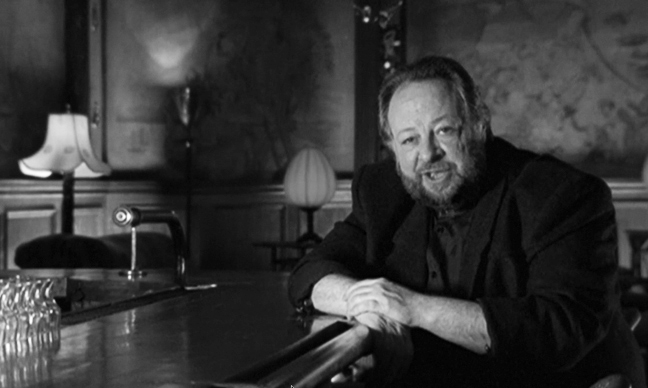 Ricky remembered. But wait, there's more: Ace internet detective Bill Mullins noted on the Genii Forum that several of the talks at the Los Angeles memorial appear in a magazine called The Threepenny Review, Summer 2019. Specifically, it contains the words of Sally Lapiduss, Dan Chariton, Michael Weber, Eddie Gorodetsky, David Mamet, and Mark Singer. You can purchase a copy of it here. |
|
|
MAGNIFICENT SEVEN, TAKE TWO -- Back in April (and May), it was a great pleasure to review Nick Trost's Subtle Card Creations Volume 7. Unfortunately, a change of printers caused a slight delay in publication. I am pleased to report that copies are now on hand for a mere $50 each and shipping from a new site but from old friends at hrmagicbooks.com. 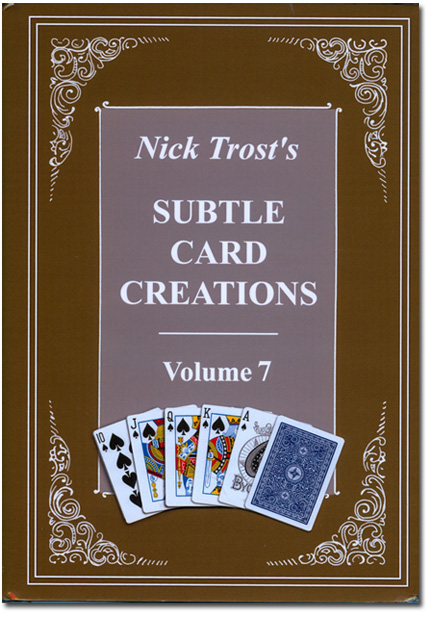 Now shipping! Trost's brilliant tricks are accessible to anyone and great fun to work through. Repeated from my April and May reviews, you may particularly enjoy these: All Backs Royal Flush. You cleanly display five cards with backs on both sides. Following a through the fist flourish, the cards morph to a royal flush with faces. And the trick cleans up nicely. Fun to watch. Blackjack Lesson. A nutty plot but fun to watch and easy to perform. Show four cards as two pairs of red tens. A score of 20 each, not good enough in blackjack. The four cards change to two blackjack hands, each an AS and a JS. But you are a poker player, so the cards change to five jokers. 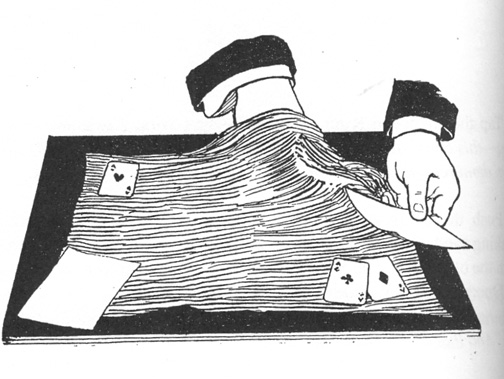 Vintage illustration from Volume 3. One of my favorites of the entire series was Shuffle Tracking, from Volume 3. Via a poker deal involving 25 cards, the magi deals two, three, four, six, seven, or eight hands, at spectator request. (This is repeated as desired, the sequence owing to Roy Walton.) The dealer receives a royal flush, his opponents receive four pat hands named through amusing insider poker lingo. Volume 7 explores further variations. Shuffle Tracking a Royal Flush begins by extracting a royal, then controlling it despite the two through eight hands, the other players receiving 9 to 5 straights. Shuffle Tracking Another Version is similar to the Volume 3 effect, the dealer eventually getting a straight flush and the others four strong pat hands. A Draw Poker Demonstration "mixes" the cards via the Walton procedure, then ends by causing the players to draw cards to fill strong hands a la the Vernon Poker Demonstration. Even Odder. Bro. John Hamman's Odd-Even-Odd is a longtime favorite and used to be part of my regular repertoire. Nick supplies an easy and effective version. Odd and even spot cards trade places, but the odd cards become "more odd" as they turn into court cards. Total Coincidence with One Deck. If you like Juan Tamariz's two-deck version from Sonata, you should love this one-deck version. Ten-Hand Poker Deal and Repeat. This routine is a close cousin to Allan Slaight's excellent Heavy Breather. It seems impossible. I'll resort to the actual text: The performer removes the four aces and the KH, explaining that he will demonstrate “shuffle tracking” with these five cards. A spectator shuffles the rest of the deck, which is then divided into five packets. The four aces and the KH are inserted into the five packets. Each packet is shuffled by running cards in a random fashion at the spectator’s discretion. The spectator dictates how many cards are run in each packet. The packets are stacked in any order, then dealt into ten poker hands. The performer predicts which hand the aces and KH will fall in—and he is correct! The tenth hand—the performer’s—is the winner. It contains a straight flush in spades. The effect is repeated with the spectator losing the straight-flush cards in the deck himself. Again ten hands are dealt, and the performer ends up with the straight flush in the tenth hand! Ace to Five. A very easy version of the ambitious-type five-card trick in which the ace through four of spades rise to the top, then the five of spades turns into the five of hearts. What knocks this into orbit is that you are left dirty with a reversed card, and you clean that up via a strong card discovery trick. Separating the Men from the Boys. Another visual, fun to watch effect. Four kings and four jacks (men and boys) alternate. Two boys and two men are dealt to the table. But suddenly the cards in your hand are all kings, and those on the table are ... queens! In Phase 2, the four jacks reappear and are placed on top of four piles. Suddenly, they all congregate on one pile and are set aside. The top cards of the piles turn out to be the four kings who unite with a queen of each suit to form four royal marriages. Soapy Smith's Klondike Poker Deal. In a 20-card game between Reverend Bowers, Slim Jim Foster, the sucker Harvey Henderson from Indiana, and Soapy Smith, Soapy's straight flush beats Harvey's full house. Even though the spectator is allowed a legit riffle shuffle, what endeared me to the routine is the milk build shuffle justified by the patter "in Alaska the dealer’s fingers were so cold, about the only way he could shuffle was to strip off the top and bottom cards and drop them on the table."  Vintage illustration from Volume 7. The Lollapalooza Hand. Spectator seems to win with a straight flush, but the dealer tops him with an unbeatable Lollapalooza hand (2,4,6,8, and 10). Following a spectator riffle shuffle and cut, spectator seems to win with his own Lollapalooza hand, but dealer takes all with his straight flush. Why? Because a Lollapalooza hand is only good once a night! A Passing Thought. A fan of aces, four red-backed and four blue-backed. Any ace thought of by a spectator leaves its group and appears among the aces of the contrasting color. Clock-a-rama. I love clock effects ... and predictions with surprise endings. From the text: "The performer writes a prediction and sets it aside in full view. The deck is shuffled and a spectator thinks of any hour on a clock from 1 to 12, removes that number of cards and hides them. The performer deals a card clock. The spectator cuts the deck proper, and the point cut to is marked. The performer now tells the spectator how many cards he cut off. His cards are counted to verify this. Now the performer counts to the corresponding hour on the clock; it is the 8H. The card cut to by the spectator is the 8D— the mate of the selection! For the climax, the prediction is revealed. It says that the spectator will select a red card, which is true, but this is not too impressive until the cut-off cards and the rest of the cards in the clock are turned face up—they are all black!"
MAGIC AT THE BPP -- Last October, reporting on Glitches in Reality with Simon Coronel, we introduced the Bloomington Playwrights Project, whose magic-friendly director Chad Rabinovitz showcases original and contemporary plays only. This month Chad premiered two more magical productions, Mind Tricks with mentalist Max Major and Simon Coronel's Magic Smackdown. Max Major returns to the stage following an absence to recover from Lyme disease, bringing a high-energy, hip, modern, youthful brand of mentalism. I tallied nearly a dozen strong routines in a fast 90 minutes, only one involving a deck of cards. Max opened with a lottery ticket prediction in a giant balloon (that fooled me!) and closed with a locked box prediction of virtually everything that happened and was happening in the show. The audience of me, my granddaughter, a handful of local magicians, and some 80 BPP regulars loved every moment. Per the Bloomington Herald-Times review: "You will hate yourself if you miss this man, this creature, this unbelievable doer of weird things. ... You will gasp. Yell even, as we all did Thursday night." Internationally famous disc jockey DASTAN backed Max up, providing techno mood music or punctuating the show with 21st-century versions of rim shots. All in all a delightful show, with many instances that felt like real magic. Annemann would have approved.  Max enjoys the standing O. And then we have Simon Coronel with his magical game show Smackdown, billed as a combo of "Penn&Teller: Fool Us," "Whose Line Is It Anyway," and "America's Got Talent." 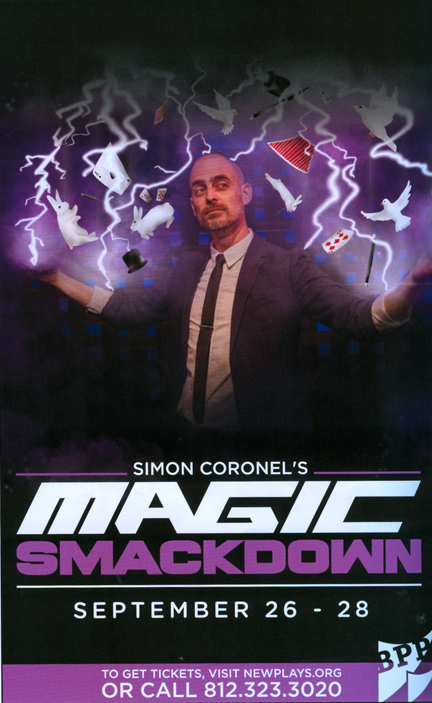 Simon is back with a new show. The gifted trio of Simon, Nick Paul, and Robert Ramirez vied for glory and a big mystery prize. Following a getting-to-know-you routine from each each, there were four rounds of competition: Lightning Round (magic in a minute), Music Round (magic accompanied by a song shouted out from the audience), Object Round (impromptu magic performed with objects borrowed from the audience), and Bonus Round (each magician's best). Voting was conducted by smart phone with each round hotly contested. Each performer held his own, with the magic delightfully eclectic and consistently funny. Nick impressed me with a signed gift card to wallet using my granddaughter's gift card, Robert fooled me badly with a liquid and bucket routine (sort of Sands of the Desert), and Simon makes me jealous that he can do a complete killer routine using nothing but his fingers. Nick and Robert were new to me, both great at physical comedy, and Robert especially impressed with his extended skill set: he can tap dance (while tearing a newspaper), play ukulele, sing (sort of), and do eye-popping old school card manipulation, purportedly learned from a 25-cent Thurston booklet. On the opening Thursday of a three-night run, Robert scored a come from behind win, and the big prize tied everything together. (I'll keep the details a secret.) 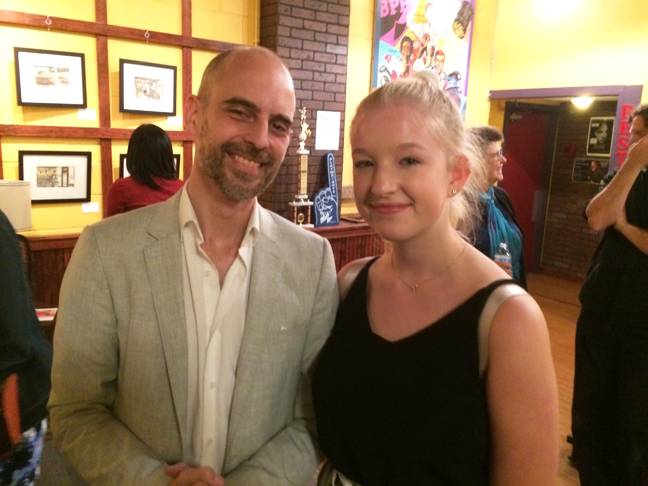 Simon and a young fan. On weeknights especially, the BPP crowd is a senior crowd. One of the funniest moments, in the call-out-a-song Music Round: Lady: Lydia, the Tattooed Lady. Simon: Who is that by? Lady: Well, Groucho Marx sang it. Simon (laughing): There's a generational gap from the songs we had in rehearsal. The show is a lot of fun. Simon told me they had been working on it off and on for three years, and it's come together nicely. It's a brilliant piece of theater, and the performers seemed to be having as much fun as the audience. I hope a tour or a TV deal is in the offing. |
|
 A young teenager annotates Practical Mental Effects.
"I've found that a person would rather have you tell him the maiden name of his mother than see you find a card ...."
-- Annemann
Follow us on Twitter. Little Egypt Magic is the erratically updated web site of Steve Bryant, spawned (the site, not Steve) by a former internet magazine known as The Little Egypt Gazette/for magicians only. Steve Bryant is an obscure magician and writer who generates this site from an iMac in Bloomington, Indiana. He used to frequently journey to and perform magic in Little Egypt, the local name for extreme southern Illinois, where the towns bear such names as Cairo, Thebes, and Karnak. Past issues of this web site: Index to Past Issues Closing photos since 2007: Rotogravure Notice: Any limited use of copyrighted images or quoted text is considered fair use, usually to review whatever product or event that is under discussion. If you object to use of any material, please get in touch and it will be cheerfully removed. |
A JSB Creations product
Copyright© 2019 by Steve Bryant